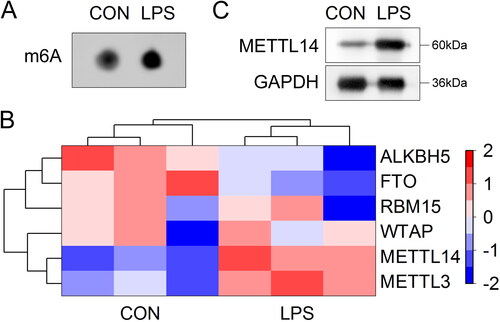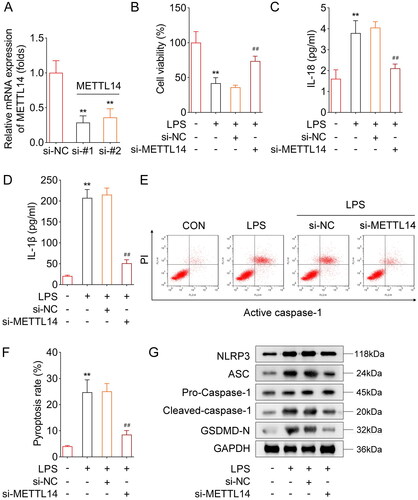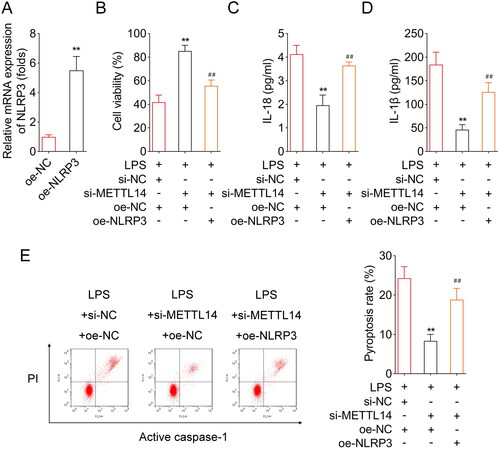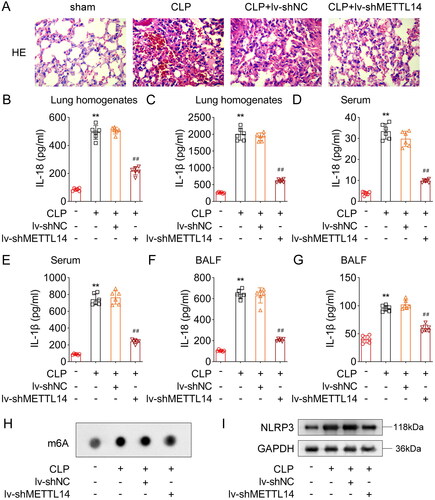Figures & data
Figure 1. LPS stimulation increased the m6A levels in the A549 cells.
The A549 cells were stimulated with 20 μg/mL LPS. (A) The m6A levels were tested by m6A dot blot assay. (B) The mRNA expressions of m6A modification-related genes were detected by RT-qPCR and expressed as hot map. (C) The protein levels of METTL14 were measured by western blot.

Figure 2. METTL4 knockdown inhibited the pyroptosis in the LPS-stimulated A549 cells.
(A) The verification of transfection efficiency of si-METTL14 #1 and #2. The A549 cells were stimulated with LPS and treated with si-METTL14. After that, (B) the cell viability was detected by CCK-8 assay. The IL-18 (C) and IL-1β (D) contents were detected by ELISA kits. (E, F) The pyroptosis rate was measured by flow cytometry. (G) The protein levels of NLRP3, ASC, Cleaved-caspase-1 and GSDMD were detected by western blot. **P < 0.01 VS control group. ##P < 0.01 VS LPS + si-NC group.

Figure 3. METTL14 regulated the m6A levels of NLRP3.
(A) After METTL14 knockdown, the m6A levels of NLRP3, ASC, caspase-1 and GSDMD were detected by Me-RIP assay. (B) The interaction between METTL14 and NLRP3 was confirmed by RIP assay. (C) After METTL14 knockdown, the mRNA levels of NLRP3 were detected by RT-qPCR assay. (D-E) The m6A methylation sites of NLRP3 were obtained from SRAMP online database. The dual-luciferase reporter assay was performed to analyzed the relationship between METTL14 and NLRP3 after site 1 (F), site 2 (G), site 3 (H), and site 4 (I) mutations. (I) The mRNA stability of NLRP3 was determined by RT-qPCR after Actinomycin D treatment. **P < 0.01.

Figure 4. NLRP3 overexpression reversed the role of METTL14 knockdown in the LPS-stimulated A549 cells.
(A) The verification of transfection efficiency of oe-NLRP3. The LPS-stimulated A549 cells were transfected with si-METTL14 and oe-NLRP3. After that, (B) the cell viability was detected by CCK-8 assay. The IL-18 (C) and IL-1β (D) contents were detected by ELISA kits. (E) The pyroptosis rate was measured by flow cytometry. **P < 0.01 VS LPS + si-NC + oe-NC group. ##P < 0.01 VS LPS + si-METTL14 + oe-NC group.

Figure 5. METTL14 knockdown alleviated the sepsis-induced ALI in vivo.
The CLP treated mice were used to establish the sepsis-induced ALI model. After METTL14 knockdown, (A) the HE staining was performed to observe the lung tissue structure. The IL-18 and IL-1β content the lung homogenates (B, C), serum (D, E) and BALF (F, G) were measured using ELISA kits. (H) The m6A levels were tested by m6A dot blot assay. (I) The protein levels of NLRP3 were detected by western blot assay. **P < 0.01 VS Sham group. ##P < 0.01 VS CLP + lv-shNC group.

Availability of data and materials
The datasets used and/or analyzed during the current study are available from the corresponding author on reasonable request.
